The Best Indoor Plants for Your Living Room
Published On: 18 October 2024
There’s no denying it — your living room is where life happens. It’s the space where you unwind after a long day, entertain guests, or spend time with family. But have you considered how adding houseplants could brighten up your living space? Not only do houseplants elevate your living room décor, but they also purify the air, reduce stress, and boost overall well-being.
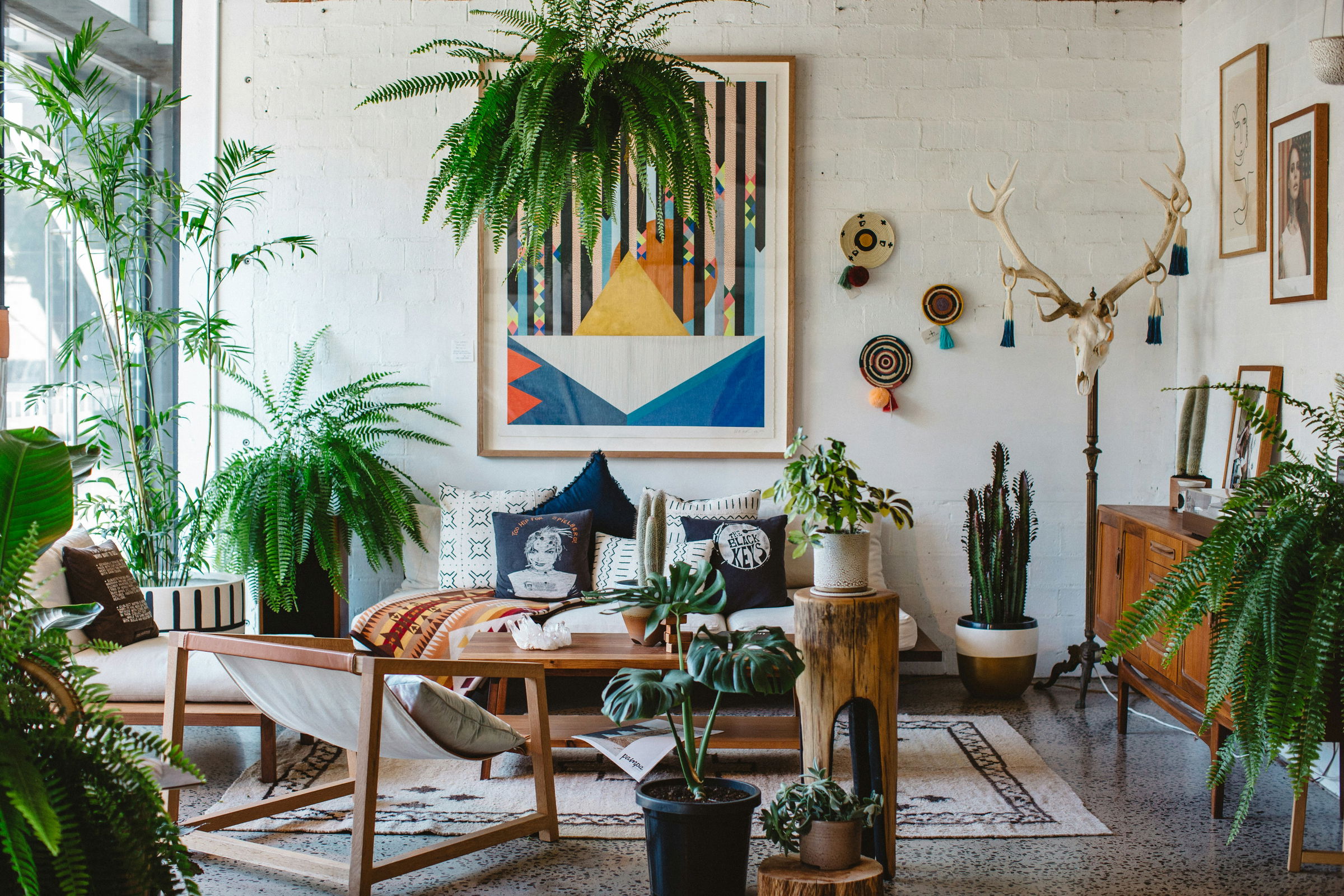
In this guide, we’ll dive deep into the 10 best indoor plants for your living room, how to care for them, and where to place them for maximum effect.
Table of Content
- Why Add Indoor Plants to Your Living Room?
- Scientific Benefits of Indoor Plants on Well-Being
- What’s the Most Important Thing to Consider When Choosing Living Room Plants?
- Aesthetic Plants for Living Rooms
- #1 Monstera Deliciosa
- #2 Fiddle Leaf Fig
- #3 Calathea
- Air-Purifying Plants for Living Rooms
- #1 Peace Lily
- #2 Snake Plant
- #3 Spider Plant
- Low-Light Indoor Plants for Living Rooms
- #1 ZZ Plant
- #2 Philodendron
- Low-Maintenance Indoor Plants for Living Rooms
- #1 Rubber Plant
- #2 Aloe Vera
- #3 Succulents
- Fragrant Indoor Plants for Living Rooms
- #1 Lavender
- #2 Jasmine
- Pet-Friendly Indoor Plants for Living Rooms
- #1 Spider Plant
- #2 Areca Palm
- Best Placement for Living Room Plants
- Corners
- Shelves
- Coffee Tables
- Lighting Solutions for Low-Light Living Rooms
- Common Mistakes to Avoid When Caring for Living Room Plants
- Conclusion: Transform Your Living Room with Greenery
Why Add Indoor Plants to Your Living Room?
Indoor plants provide a multitude of benefits:
-
Air Purification: Many houseplants naturally remove toxins like formaldehyde and carbon monoxide, leaving your home fresher. A good air-purifying plant, such as the spider plant or peace lily, can significantly improve the indoor air quality in your living room indoor.
-
Stress Relief: Studies show that surrounding yourself with greenery can lower stress levels and promote relaxation, making your living room an oasis of calm. Indoor plants for living room can bring tranquility to your space and enhance your mood.
-
Aesthetic Appeal: Plants for home decor add texture, color, and a touch of nature, instantly elevating your space. Whether you’re looking for tropical plants or compact trailing plants, there’s something to suit every living room décor.
-
Mood Enhancement: Greenery has been linked to improved mood and energy levels, perfect for a room where you entertain or unwind. Living room plants can transform your room into a vibrant, welcoming area, making them among the best plants for living room decor.
Adding plants can also align with feng shui principles, improving the energy flow in your living space. Certain plants like the money tree and jade plant are believed to attract wealth and good luck, making them an ideal choice for living spaces where you seek harmony and prosperity.
Scientific Benefits of Indoor Plants on Well-Being
Research consistently highlights how indoor plants positively affect physical and mental health. Plant species act as natural air purifiers, removing pollutants and increasing oxygen levels. Studies suggest that tending to live plants lowers blood pressure and improves focus and productivity. In a living room setting, this can foster a more relaxed, energized, and harmonious atmosphere, contributing to better quality time spent with loved ones.
NASA's Clean Air Study identified several best air-purifying plants that help remove harmful toxins from the air, including benzene, formaldehyde, and trichloroethylene. The presence of plants also improves indoor humidity levels, reducing the risk of respiratory issues and keeping your skin healthier during dry seasons.
What’s the Most Important Thing to Consider When Choosing Living Room Plants?
Before choosing living room plants, consider these factors:
-
Light Conditions: Living rooms vary in light availability. Some rooms may have bright sunlight and plenty of natural light, while others might rely on artificial lighting. Match your houseplants to the room’s lighting conditions—some plants thrive in low light, while others need medium to bright indirect light. For instance, a money plant thrives well in medium to low light, while succulents prefer direct light.
-
Maintenance: If you're a new plant parent or don’t have much time, opt for easy to care varieties like the ZZ plant or snake plant that require minimal care but still offer great benefits. These plants can tolerate being neglected for longer periods, making them perfect for busy households.
-
Room Size: Larger rooms can handle dramatic, large indoor plants like the fiddle leaf fig or monstera, while smaller spaces benefit from compact options like succulents or a money tree. Tall plants can be placed in corners to make a statement, while small, trailing plants look beautiful on shelves or coffee tables.
Aesthetic Plants for Living Rooms
When it comes to aesthetic houseplants, you want options that are not only functional but also enhance your living room’s look and feel. The right houseplants can elevate your home decor and become conversation starters for your guests.
#1 Monstera Deliciosa
Known as the Swiss cheese plant for its large, leaves with holes, the Monstera adds a tropical plant flair with its large, dramatic leaves. Perfect for modern or boho-style spaces, this plant species for home elevates your space effortlessly. It’s also a favorite among plant parents who love bold greenery.
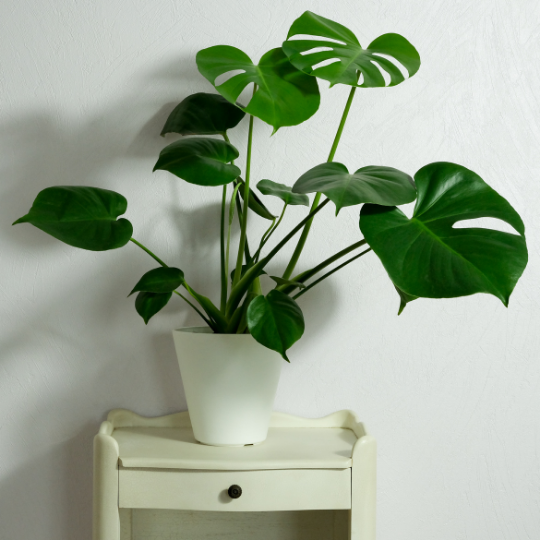
Light: Thrives in bright, indirect light but can adapt to lower light conditions. Direct sunlight should be avoided as it can damage the leaves.
Water: Water when the top inch of soil is dry. This is usually once a week, but frequency can vary depending on room conditions.
Benefits: It acts as a natural air purifier, filtering out toxins and enhancing your living room's air quality.
#2 Fiddle Leaf Fig
Known for its large, heart-shaped leaves, the fiddle leaf fig is ideal for living room corners. It brings a bold statement to your home decor, though it requires specific care. This plant thrives in living spaces with ample bright sunlight and can grow tall enough to become a living room centerpiece.
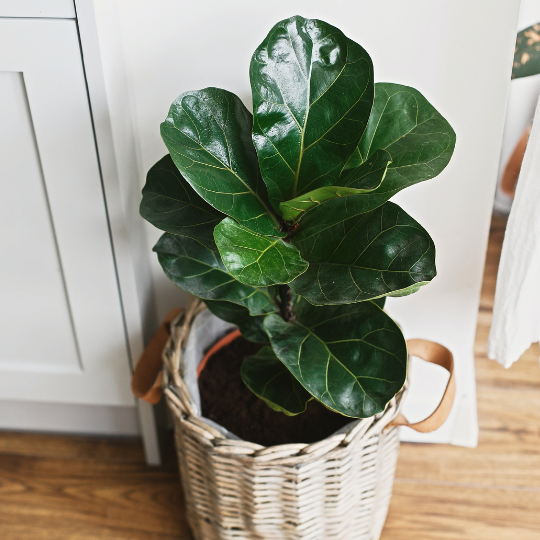
Light: Thrives in bright, indirect light. It can tolerate some direct sunlight but be cautious as too much can burn the leaves.
Water: Water thoroughly when the top inch of soil is dry. Overwatering or inconsistent watering can lead to leaf drop, so balance is key.
Benefits: Enhances indoor air quality by removing toxins. Its large leaves add a touch of modern elegance, making it a popular choice for living rooms.
#3 Calathea
This foliage plant brings a vibrant, artistic touch with its stunning variegated leaves. A perfect addition to any room, especially where there’s medium to bright indirect light. Known for its “prayer” leaves that fold up at night, Calatheas add a dynamic touch to your indoor space.

Light: Prefers moderate to low, indirect light. It does well in filtered or diffused light as direct sun can scorch the leaves and diminish the vibrant colors.
Water: Keep the soil consistently moist, but not soggy. Water when the top layer of soil feels dry, and maintain higher humidity levels for optimal health.
Benefits: Adds a pop of vibrant greenery to your living room decor and acts as a natural air humidifier, making your indoor environment healthier and more comfortable.
Air-Purifying Plants for Living Rooms
If you’re looking to improve the indoor air quality of your living room, consider adding some of the following best air-purifying plants. These plants are not only aesthetically pleasing but also work to remove harmful toxins from the air, making your living room indoor space healthier for you and your family.
#1 Peace Lily
Known for its ability to purify the air, the peace lily is one of the best plants for living room. It not only removes toxins like benzene and formaldehyde but also adds elegance with its white blooms. But keep in mind that this plant is toxic to cats and dogs.

Light: Thrives in low to moderate indirect sunlight, making it adaptable to different areas of your living room. It can also tolerate fluorescent lighting well, making it suitable for rooms without much natural light.
Water: Keep the soil consistently moist, but not soggy. Allow the top layer of soil to dry slightly between waterings, and mist occasionally to maintain humidity.
Benefits: Along with its air-purifying properties, the Peace Lily adds elegance and tranquility with its striking white flowers. Its ability to tolerate various light conditions makes it a versatile choice for brightening up any living room corner.
#2 Snake Plant
The snake plant is one of the best air-purifying plants for your home. Known to release oxygen at night, it improves indoor air quality and this plant is easy to care for, making it ideal for every corner of your home.

Light: Adapts well to low light but thrives in bright, indirect light. It's highly versatile and can be placed anywhere in the living room, from dim corners to bright windowsills.
Water: Allow the soil to dry out completely between waterings. The Snake Plant stores water in its leaves, so it can tolerate periods of drought. Overwatering should be avoided to prevent root rot.
Benefits: Enhances indoor air quality by releasing oxygen at night and reducing toxins. Its sleek, vertical growth adds modern elegance, making it an excellent choice for a sophisticated living room.
#3 Spider Plant
Spider plants are perfect for living room indoor decor. They’re known to remove carbon monoxide and other pollutants, making them essential for air purification. These plants are easy to grow and produce baby plants, which can be propagated.

Light: Prefers bright, indirect light but is quite adaptable to lower light conditions. Direct sunlight should be avoided as it can cause the leaves to scorch.
Water: Water when the soil feels dry to the touch, generally about once a week. While Spider Plants are fairly drought-tolerant, consistent moisture (without waterlogging) keeps them healthy and vibrant.
Benefits: Excellent air purifier, easy to grow, and enhances indoor spaces with its cascading foliage. The Spider Plant also brings a sense of movement and energy to your living room with its abundant growth and frequent production of baby plants.
Low-Light Indoor Plants for Living Rooms
Many living rooms don’t receive consistent bright sunlight throughout the day. For such spaces, choosing low light plants can make a huge difference in adding greenery without the need for constant sunlight exposure.
#1 ZZ Plant
One of the most resilient houseplants, the ZZ plant thrives in low light conditions, making it a great option for darker living spaces. Its shiny, waxy leaves add a touch of elegance to any room, and it’s one of the easiest plants to maintain.

Light: Tolerates a variety of light conditions, from low to bright indirect light. It can handle dim spaces, but it will grow more vigorously in medium light.
Water: The ZZ plant needs only minimal watering; allow the soil to dry out almost completely before watering again. Overwatering can lead to root rot, so it’s best to err on the side of underwatering.
Benefits: A low-maintenance, beautiful plant that can adapt to various light conditions, the ZZ plant also acts as a natural air purifier, filtering out toxins and enhancing indoor air quality. Plus, its upright growth and sleek leaves add an effortless touch of elegance to your living room.
#2 Philodendron
This trailing plant species is an excellent choice for low light rooms. It adds a lush, tropical feel to your living room and is easy to care for.

Light: Philodendrons thrive in low to bright indirect light. However, exposure to direct sunlight can scorch their leaves, so it's best to keep them in a place with diffused light or away from direct sun rays.
Water: Allow the top inch of soil to dry out before watering. While Philodendrons like moist soil, they don't do well with standing water. It's important to ensure proper drainage to prevent root rot.
Benefits: This plant is excellent for purifying the air, removing toxins like formaldehyde from your living space.
Low-Maintenance Indoor Plants for Living Rooms
For those with busy schedules, low-maintenance indoor plants can provide the beauty of nature without the hassle. These plants require minimal care and are perfect for beginners or people so they'll all good even if you forget to water them.
#1 Rubber Plant
A popular indoor plant choice, the rubber plant adds elegance with minimal care. Its deep green leaves make it one of the best plants for home decor, and it can grow into a small tree if given the right conditions.

Light: It thrives in bright, indirect light but is also quite adaptable to lower light conditions. However, to achieve optimal growth and vibrant leaf color, ensure it gets plenty of indirect sunlight.
Water: Allow the soil to dry out slightly between waterings. This plant prefers moderately moist soil but does not like to sit in water, so make sure it has good drainage to avoid root rot.
Benefits: The Rubber Plant is known for its ability to purify the air by removing toxins from your living room. Its strong vertical growth can also add a structured, sophisticated look, helping to elevate the design of any indoor space.
#2 Aloe Vera
A low-maintenance succulent that is both aesthetic and practical. It adds a sleek look to any living room and is perfect for minimal care. Aloe Vera also has medicinal properties, making it a handy plant to keep in your living room for sunburns and minor cuts.

Light: Aloe Vera thrives in bright, indirect light. While it can handle some direct sunlight, prolonged exposure to intense rays can scorch its leaves, so it's best to place it near a window where it can receive plenty of light without getting scorched.
Water: Being a succulent, Aloe Vera prefers to dry out between waterings. Water the plant every few weeks, allowing the soil to dry out completely before the next watering to avoid overwatering and potential root rot.
Benefits: Aloe Vera not only acts as an air purifier but also doubles as a first-aid plant. It enhances the living room ambiance with its spiky, fleshy leaves while providing the practical benefit of immediate skincare remedies whenever needed.
#3 Succulents
These small indoor plants are ideal for living spaces requiring minimal upkeep. They thrive in neglect and add a unique touch to your living room decor. Succulents come in many shapes and sizes, and you can mix and match different varieties for a mini indoor garden.

Light: Succulents flourish in bright, direct sunlight. A sunny window or a well-lit corner is ideal for these plants to showcase their vibrant colors and maintain their compact growth. They require at least 4-6 hours of light daily.
Water: Being drought-tolerant, succulents require infrequent watering. Make sure to allow the soil to dry out completely between waterings, as their thick leaves store moisture. Overwatering is a common problem, so it's best to water sparingly and ensure proper drainage.
Benefits: Succulents enhance your living room's decor with their diverse forms and textures, adding an aesthetic yet modern touch. Besides, they’re excellent for creating compact green arrangements that bring a natural feel to your living space without demanding much attention.
Fragrant Indoor Plants for Living Rooms
Fragrant indoor plants not only enhance the beauty of your living room but also fill the space with calming aromas. These plants are ideal for creating a soothing, stress-free environment.
#1 Lavender
Lavender is known for its calming, fragrant aroma, making it a fantastic addition to your living room. Though typically an outdoor plant, certain varieties of lavender can thrive indoors if placed near a sunny window.
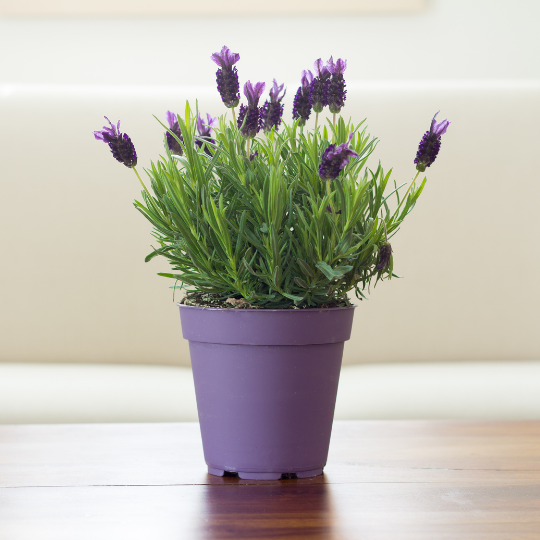
Light: Lavender thrives in bright, direct sunlight. It's best placed near a south-facing window where it can get at least 6-8 hours of sunlight daily. Lack of sufficient light may lead to reduced flowering and weak growth.
Water: Water the plant when the top inch of soil feels slightly dry. Lavender prefers well-drained soil, so be cautious not to overwater. Letting the soil dry between waterings is key to preventing root rot and keeping the plant healthy.
Benefits: The calming fragrance of lavender helps reduce stress and improve sleep quality. Its air-purifying qualities make it a great addition to your living room, where it can help create a calming environment for relaxation and mindfulness.
#2 Jasmine
Jasmine is a fragrant indoor plant that produces a sweet, floral scent, perfect for enhancing the ambiance of your living room. This flowering plant adds both fragrance and beauty to your indoor space.
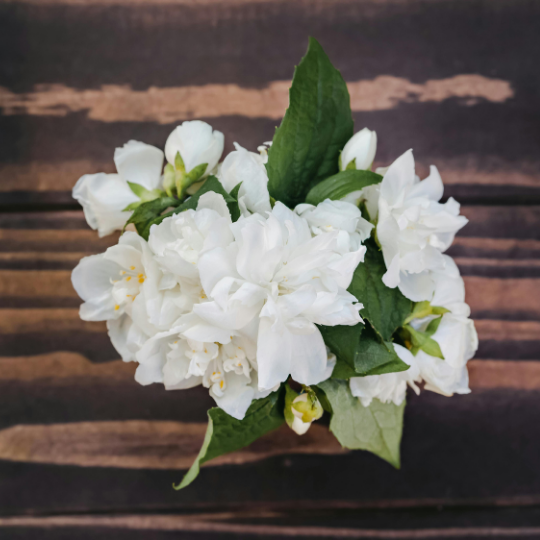
Light: Jasmine thrives in bright, indirect light but can tolerate some direct sunlight as well. Placing it near a sunny window where it gets about 4-6 hours of light per day will help the plant bloom more abundantly.
Water: Keep the soil consistently moist, watering the plant when the top layer of soil feels dry to the touch. Avoid overwatering, as Jasmine prefers well-drained soil to prevent root rot.
Benefits: Beyond its aesthetic appeal, Jasmine is known to help relieve stress, improve mood, and create a calming environment with its soothing fragrance.
Pet-Friendly Indoor Plants for Living Rooms
For households with pets, safety is a top priority. These pet-friendly indoor plants not only enhance your living room decor but also ensure your furry friends remain safe, all while improving air quality.
#1 Spider Plant
A timeless favorite, the spider plant is perfect for living room spaces and completely safe for pets. Its air-purifying qualities make it a great choice for improving indoor air in homes with cats and dogs.

Light: Spider plants prefer bright, indirect light but can also adapt to lower light conditions. Place them near a window or on a well-lit shelf, avoiding direct sun exposure, which can scorch the leaves.
Water: Allow the top inch of soil to dry out between waterings. While they prefer slightly moist soil, they are forgiving if you occasionally miss a watering session.
Benefits: Besides enhancing the greenery in your living room, spider plants are excellent air-purifiers and help improve indoor air quality. They also produce "spiderettes," or baby plants, which can be propagated and shared, making them a fantastic plant to grow and multiply in your home environment.
#2 Areca Palm
Known for its tropical appearance, the Areca Palm is another pet-friendly plant safe for cats and dogs. It adds a vibrant, tropical feel to your living room while helping to purify the air and is said to bring good luck and prosperity.
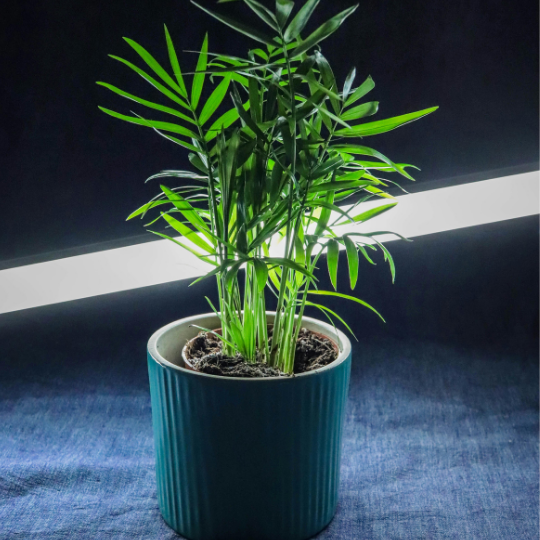
Light: Areca Palms prefer bright, indirect light and can adapt to lower light conditions, although this may slow down their growth. Placing them near a bright window with filtered light is ideal to maintain their lush green fronds.
Water: These palms enjoy a moderate level of moisture. Allow the top inch of soil to dry out before watering again. It’s important to avoid overwatering, as it may lead to root rot.
Benefits: The Areca Palm not only adds a decorative flair to your living room but also improves air quality by removing pollutants like formaldehyde, xylene, and toluene.
Best Placement for Living Room Plants
Living room plants are best placed where they can thrive while enhancing your indoor space. For large indoor plants like the fiddle-leaf fig, corners are ideal. Trailing plants like pothos or spider plants add greenery when placed on shelves, and small potted plants like succulents work well on coffee tables to complement your indoor environment.
Corners
Large plants like the fiddle-leaf fig or monstera make excellent corner fillers.
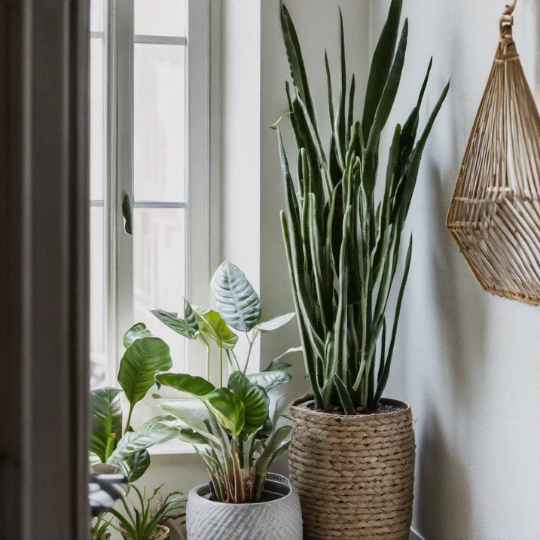
Shelves
Trailing plants like pothos or spider plants look great draping from shelves.
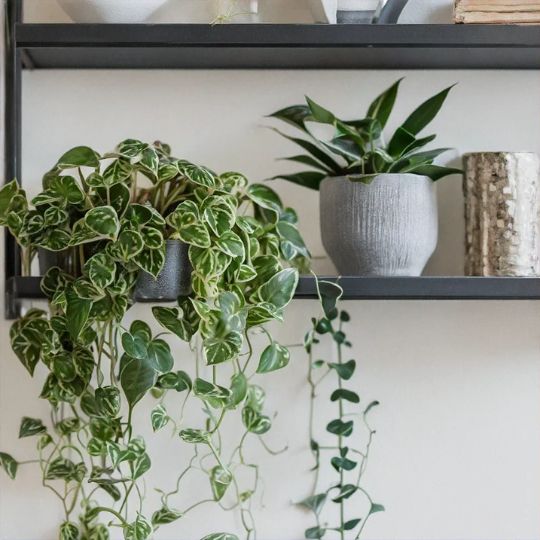
Coffee Tables
Small succulents or low-profile plants like aloe vera make great centerpiece options for your coffee table.

Lighting Solutions for Low-Light Living Rooms
If your living room lacks bright sunlight, consider using grow lights to help your indoor house plants thrive.
LED grow lights provide the ideal light spectrum for low light plants and are energy-efficient, making them perfect for plants in the living room or even bedroom plants.
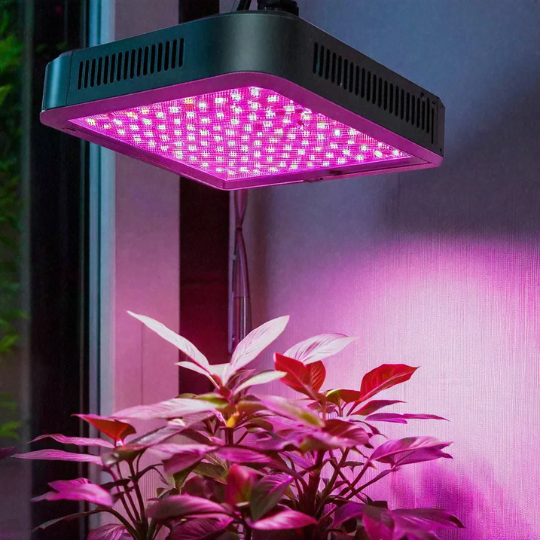
Fluorescent bulbs are another good option for office plants or areas with little sunlight. These lighting solutions can enhance your indoor environment, ensuring your plants stay healthy and happy in any indoor space.
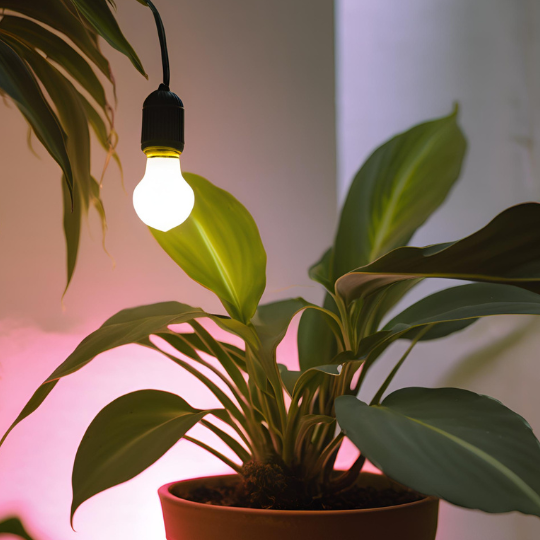
Common Mistakes to Avoid When Caring for Living Room Plants
Overwatering: Do not overwater your plants. Allow the top inch of soil to dry out before watering again, especially for low-maintenance plants and those in low-light areas.
Lack of Drainage: Ensure your potted plants have proper drainage holes to avoid water accumulation and root rot, keeping your living room plants healthy.
Incorrect Placement: Avoid placing sun-loving plants like the money plant in low-light spots. Match your plants’ light needs to the conditions in your living room to ensure they thrive.
Conclusion: Transform Your Living Room with Greenery
By adding the right indoor plants, you can transform your living room into a vibrant, relaxing space that promotes well-being and elevates your home decor. Whether you choose air-purifying plants, low-maintenance options, or pet-friendly varieties, the key is finding what works best for your lifestyle and light conditions. Start small, experiment with placement, and watch your living room blossom into a green oasis!
Read Next...
Affiliate Disclaimer:
This website contains affiliate links. All that means for you is that if you click on one of my links and make a purchase, I receive a small commission. This helps me keep this content 100% free! But rest assured, I only recommend products I know and trust! Happy Planting!

